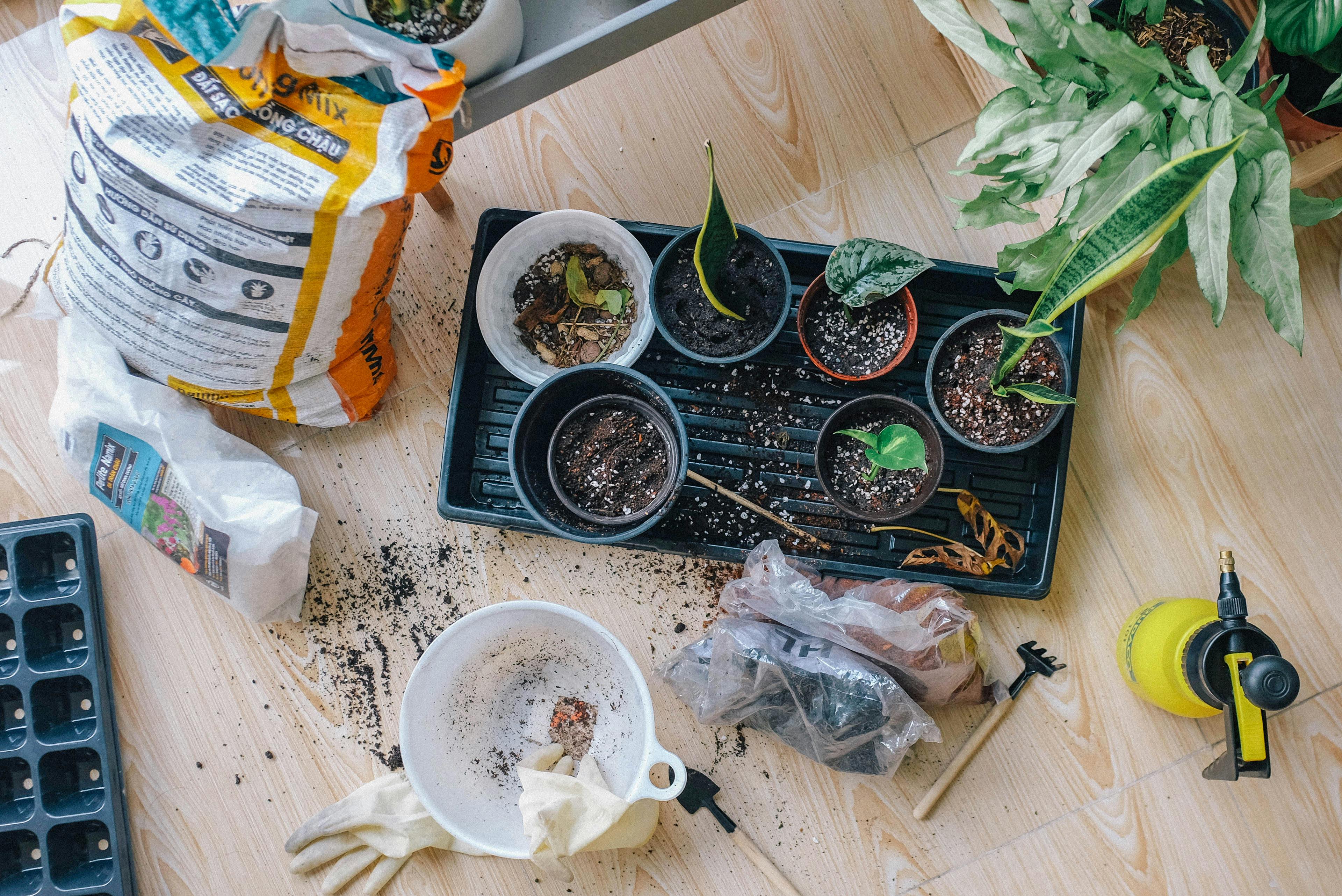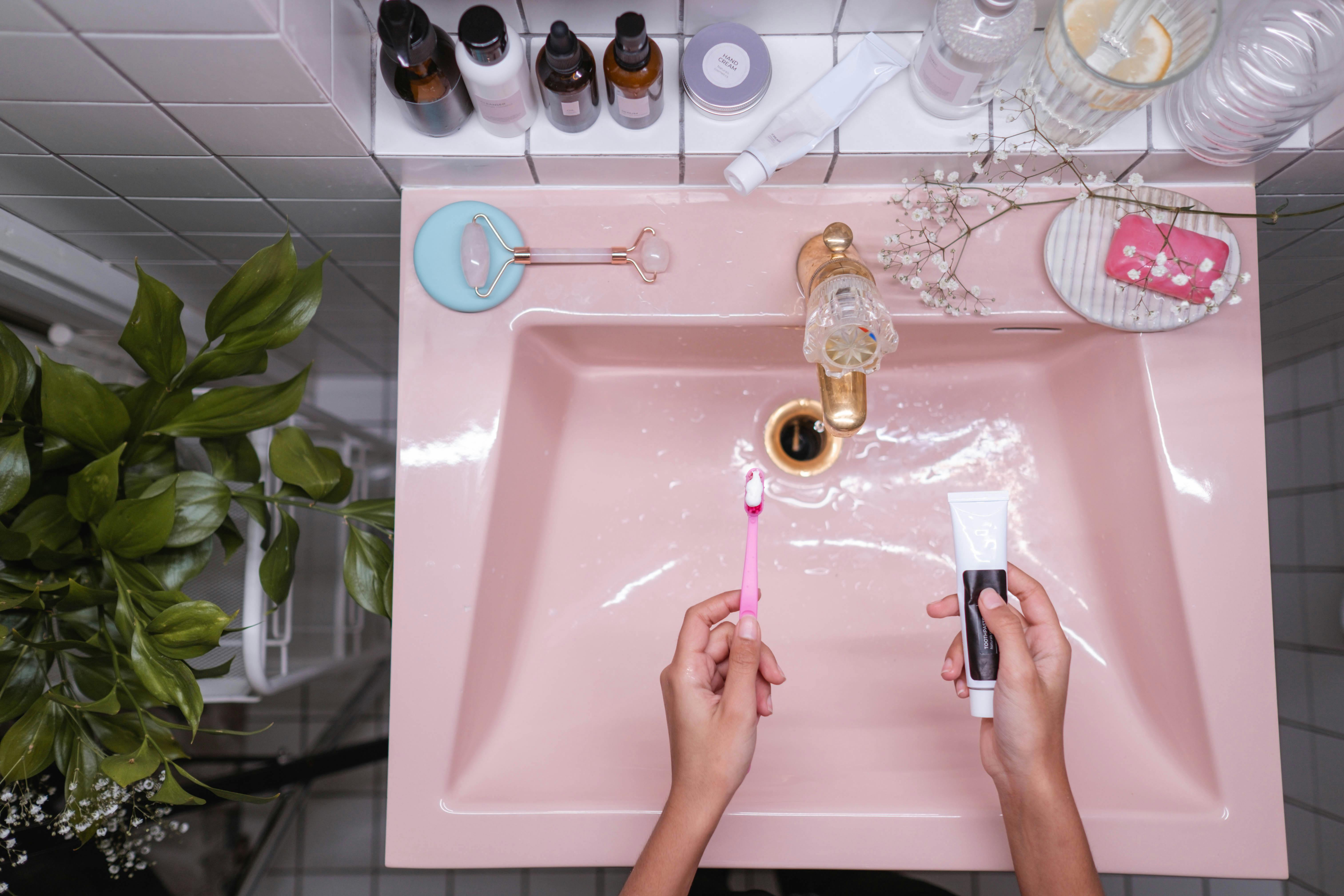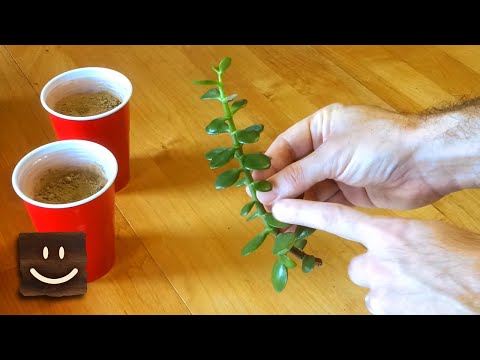Propagating a jade plant is an easy and rewarding process. In this guide, we will provide you with the information needed to successfully propagate your jade plant using stem cuttings. With just a few simple steps, you can have new plants to give away as gifts or to grow in your own home.Propagating a Jade Plant is relatively easy and can be done by cuttings or layering.
To propagate by cuttings:
1. Select a healthy stem on the Jade Plant and cut it off using a sharp knife or pruning shears.
2. Remove the lower leaves from the cutting, leaving two or three at the top of the stem.
3. Dip the end of the cutting into rooting hormone, then place it in a pot filled with well-draining soil mix.
4. Water lightly, and place the pot in a warm location with bright, indirect light until roots form (this can take several weeks).
5. When roots form, water more regularly to keep the soil slightly moist but not soggy. Fertilize monthly during active growth periods with an all-purpose liquid fertilizer diluted to half strength or less.
To propagate by layering:
1. Select a flexible stem on your Jade Plant that is long enough to hang down from where it is rooted into soil in its current pot.
2. Carefully bend it down and partially bury it in another pot filled with well-draining soil mix, making sure to leave some of the stem exposed above soil level so that you can easily keep track of where you buried it. Secure the stem in place using rocks or small stakes if necessary.
3. Keep soil moist and provide bright, indirect light until roots form (this can take several weeks).
4. Cut off rooted layer from mother plant and repot separately when ready; water regularly to keep slightly moist but not soggy, fertilize monthly during active growth periods with an all-purpose liquid fertilizer diluted to half strength or less
Preparing the Plant for Propagation
Before you start propagating a plant, you need to make sure that it is in good condition and ready for the process. This includes inspecting the plant for any signs of disease or pest damage, pruning away any dead or damaged growth, and ensuring that the soil is well-drained and nutrient-rich. If necessary, you may also need to repot the plant into a larger pot with fresh soil.
Once you have prepared the plant for propagation, you can begin by taking cuttings from healthy parts of the plant. When taking cuttings, use a sharp knife or scissors to make clean cuts just below a node on the stem. Make sure that each cutting has at least two sets of leaves and one node with roots attached. Once all of your cuttings are taken, place them in a shallow container filled with water. Allow them to sit in the water overnight so that they can form their own root system before planting them in soil.
Once your cuttings have had time to develop their own roots, they are now ready to be planted in soil. Use a potting mix specifically designed for propagation and fill your containers with it before adding the cuttings. Make sure each cutting is firmly placed in the soil and allow enough space between them for air circulation. Finally, water your newly planted cuttings thoroughly and keep them moist by misting them daily until they start growing again. With proper care, your propagated plants should be ready to transplant into larger containers within a few weeks!
Cutting the Stem
Pruning, or cutting the stem of a plant, is an important gardening practice. It helps keep plants healthy and encourages growth. Pruning can help reduce the spread of disease and pests, improve flowering and fruiting, and encourage more vigorous growth. Pruning also helps to give plants a more attractive shape and form. Depending on the type of plant being pruned, there are different techniques to use.
When pruning trees or shrubs, it is important to make sure that you are cutting at the right angle and not leaving too much of a stub. You should also avoid cutting off too much at once as it can weaken the plant or leave it open to disease. The best way to prune is to remove just enough of the top growth so that it does not interfere with the shape or size of the plant.
When it comes to pruning flowers, it is important to cut back only dead or damaged stems as this will help keep your plants healthy and promote better flowering in the future. You should also be sure to cut back any stems that are growing too close together as this can lead to overcrowding in your garden. Lastly, be sure to remove any dead or diseased leaves from your flowers as this will help prevent any further spread of disease or pests throughout your garden.
Pruning is an important part of gardening that should not be overlooked. Taking the time to properly prune your plants can help ensure they stay healthy and productive for many years to come!
Creating a Suitable Environment for Rooting
Rooting, or the process of gaining privileged control of a device, is a popular method for users to unlock additional features on their mobile device. It allows users to customize their device further than ever before and create their own unique experience. However, in order to properly root a device, it is important to first create an environment that is suitable for rooting.
This means making sure that the device is sufficiently powered and has enough storage space to accommodate any new software or applications that might be installed during the rooting process. Additionally, it is important to ensure that the device has the most up-to-date version of its operating system and has all the necessary drivers installed before beginning the rooting process.
For devices running Google’s Android operating system, this also means making sure that the user has enabled USB debugging on their device. This setting can be found in the developer options menu and will allow for easier communication between the computer and smartphone during rooting.
Finally, it is important to make sure that any security measures put in place by the manufacturer are disabled or bypassed before beginning any rooting process. Many manufacturers add layers of security to prevent users from tampering with their devices’ software, so these must be disabled or bypassed in order to properly root a device.
In short, creating a suitable environment for rooting involves making sure that all necessary drivers are installed on the device, enabling USB debugging on Android devices, and disabling any security measures put in place by manufacturers. By taking these steps beforehand, users can ensure they have an optimal environment for successful rooting of their mobile devices.
Watering the Jade Plant
The Jade Plant is a succulent, and as such, it requires minimal watering. It is important to remember to water the plant only when the soil is dry. Over-watering can lead to root rot or other fungal diseases. When watering your Jade Plant, use lukewarm water and make sure not to get any water on the leaves or stems. Allow the water to soak into the soil until it begins to drain out of the bottom of the pot. Once this happens, stop watering and allow the soil to dry out completely before watering again. It is best to water your Jade Plant once every two weeks during its growing season and once every month during its dormant season.
Monitoring the Jade Plant
In order to ensure that your Jade Plant is healthy, it is important to monitor its progress on a regular basis. Check for signs of pests or disease such as powdery mildew or aphids. If you notice any of these issues, treat them immediately with an appropriate pesticide or fungicide. Also check for yellowing or wilting leaves which could indicate that your plant needs more water. Lastly, inspect the roots for signs of root rot which may require repotting with fresh soil in order to save your plant.

Repotting the Jade Plant
Repotting a jade plant is an important part of its care and maintenance. It ensures that the roots are healthy and that the plant is getting enough nutrients. Repotting your jade plant should be done every two to three years, or when you notice it has outgrown its current pot. When repotting your jade plant, make sure to use a pot with drainage holes, as this will help to prevent root rot. You should also use a well-draining soil mix specifically for succulents and cacti. Lastly, make sure to water your jade plant after repotting to help it establish a healthy root system.
When repotting your jade plant, you should choose a pot that is only one to two inches larger than its current pot. This will allow plenty of room for growth without putting too much stress on the roots. Remove the plant from its current pot, gently shaking off any excess soil from the roots. If you notice any excess roots that are dead or diseased, trim them back carefully with garden scissors or shears. Place some of the new soil mix in the bottom of the new pot and place your jade plant in it before filling in more soil around it until it is covered completely.
Once you’ve repotted your jade plant, give it plenty of indirect sunlight and water every two weeks or so during its growing season (spring and summer). Be careful not to overwater as this can cause root rot and other problems. You should also fertilize your jade plant every two months during its growing season using a nutrient-rich liquid fertilizer for succulents and cacti. With proper care and maintenance, your jade plant will thrive for many years!
Caring for a Newly Propagated Jade Plant
Caring for a newly propagated Jade Plant is relatively simple. The plant requires adequate light, a well-draining soil, and occasional waterings. It is important to provide the right conditions for the plant to thrive. To begin, choose an area with bright indirect light and make sure to rotate the plant occasionally to avoid having it lean towards the light source. A south or east-facing window is ideal for giving your newly propagated Jade Plant enough light.
The soil should be well-draining and of good quality. A mixture of potting soil, cactus mix, and sand works well for promoting drainage. Make sure not to over-water your Jade Plant as it can lead to root rot and other problems with the plant’s health. Allow the top inch or two of soil to dry out before watering again and check that the container has adequate drainage holes at the bottom for excess water to escape.
Fertilizing your new Jade Plant every few weeks during its growing season will help promote growth and overall health. During winter months, you should reduce fertilizing as the plant may enter into dormancy and require less nutrients at this time of year. Keep in mind that while caring for your newly propagated Jade Plant may require some attention, it is relatively easy compared to other plants that require more effort in order to thrive.
Troubleshooting Tips for Propagating a Jade Plant
Propagating a jade plant is a great way to get more plants for free. While this process is generally straightforward, it can sometimes be challenging. Here are some troubleshooting tips to help you propagate your jade plant successfully:
Check the Soil
Make sure the soil you are using is appropriate for jade plants. Jade plants need well-draining soil that has plenty of organic material in it. If the soil is too moist, the roots of the cutting may rot. If it’s too dry, the cutting may not take root.
Monitor Your Light Levels
Jade plants need bright indirect light during propagation. If they get too much direct sunlight, they may become stressed and not take root. Monitor your light levels and adjust them accordingly.
Keep an Eye on Temperature and Humidity
Jade plants prefer temperatures between 65-75°F (18-24°C). If your room temperature falls outside this range, you may need to adjust it or find another area with more suitable temperatures. Additionally, keep an eye on humidity levels as too much or too little can also cause stress.
Water Wisely
Jade plants need to be kept consistently moist but not wet during propagation. Allow the top inch of soil to dry out before watering again and don’t let the pot sit in water for long periods of time. This will help prevent root rot.
Provide Support
You may want to consider providing support for the cutting as it takes root by using a stake or trellis system. This will help keep it upright and allow its roots to spread out evenly.
By following these tips, you should have success propagating your jade plant!

Conclusion
Propagating jade plants is a great way to increase your collection without having to purchase new plants. It is an easy process that can be done with either stem cuttings or leaf cuttings, and the results can be very rewarding. With proper care and attention, you can expect to have a healthy and thriving jade plant in no time.
Overall, propagating jade plants is not difficult and can be done with minimal effort. As long as you use the correct methods and provide the necessary care, you should have a new jade plant in no time. Propagating your own plants is an enjoyable activity that will help you appreciate your plants even more.

